Setting up environmental controls for time-lapse imaging requires precise regulation of temperature (±0.1°C) and humidity to prevent thermal drift and media evaporation. You’ll need specialized equipment like the EVOS® Onstage Incubator and monitoring software such as CellReporterXpress. Place your setup on stable surfaces with appropriate lighting conditions and guarantee reliable power sources. Consider implementing remote monitoring systems with configurable alerts for parameter deviations. These controls form the foundation for capturing stunning, reproducible time-lapse sequences.
Setting Up Environmental Controls for Time-Lapse Imaging
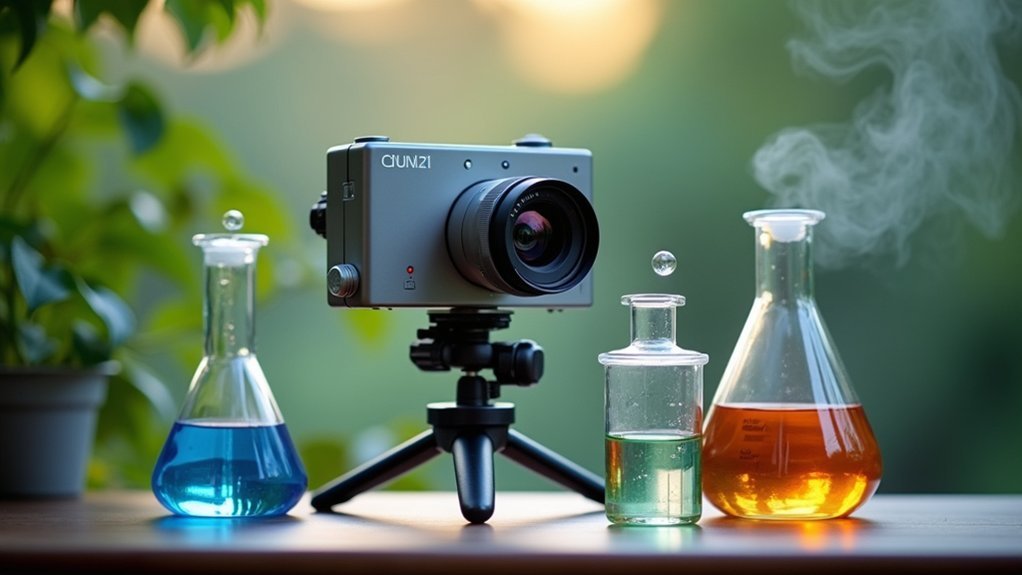
While capturing stunning time-lapse images depends on quality optics and camera settings, maintaining precise environmental conditions is equally critical for experimental success.
When setting up your environmental control system for live cell imaging, focus on precise temperature regulation (±0.1°C) to minimize thermal Z-drift and maintain focus stability throughout your experiment.
Use software like CellReporterXpress to establish real-time monitoring of temperature, humidity, and CO2 levels. This integration enables you to receive immediate alerts when conditions fluctuate beyond acceptable parameters.
Proper humidity control prevents media evaporation, ensuring cell health during extended time-lapse imaging sessions.
Consider implementing specialized equipment like the EVOS® Onstage Incubator to seamlessly integrate environmental controls with your imaging system, maximizing efficiency for long-term studies and improving experimental reproducibility.
Understanding the Critical Components of Environmental Control Systems
A well-designed environmental control system forms the backbone of successful time-lapse imaging, integrating multiple components that work in concert to maintain cell viability.
Your imaging system requires precise temperature regulation—systems like the EVOS® Onstage Incubator deliver ±0.1°C stability, minimizing thermal Z-drift and maintaining focus during long-term monitoring.
Humidity controls are equally essential, preventing media evaporation that could compromise your samples during extended data collection.
Modern systems feature real-time monitoring capabilities through software like CellReporterXpress, allowing you to track environmental conditions and receive alerts when parameters drift outside acceptable ranges.
The ability to configure settings according to your specific experimental needs guarantees reliable, reproducible results.
Selecting the Optimal Location for Time-Lapse Camera Deployment
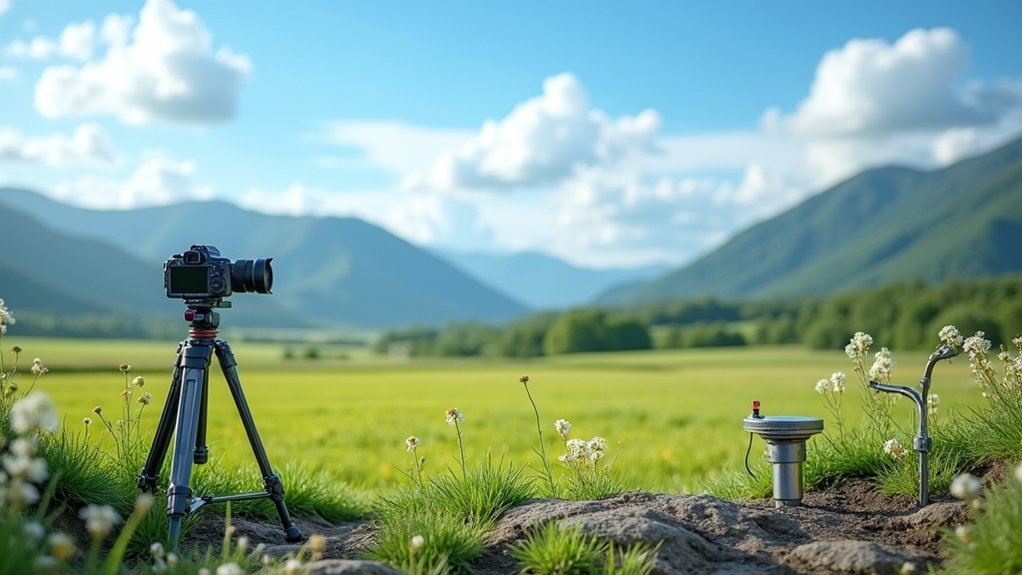
Selecting a strategic location for your time-lapse camera requires careful assessment of lighting conditions, site stability, and potential obstructions that could compromise your imaging data.
You’ll need to identify areas that capture key activity zones while ensuring your equipment remains protected from environmental hazards such as wind exposure and precipitation.
Considerations for Placement
Where you position your time-lapse camera can make or break your entire imaging project. Ideal placement requires evaluating several environmental factors simultaneously. Assess lighting conditions throughout the day, particularly during sunrise and sunset, as these golden hours provide exceptional image quality while minimizing glare issues.
Choose locations with stable, flat surfaces for mounting your equipment. Even minor vibrations can result in blurry footage, compromising your entire sequence.
Consider accessibility when selecting your site—you’ll need to perform regular maintenance checks on battery levels and camera status.
Be mindful of potential obstructions in your field of view. Trees, buildings, or growing vegetation can gradually block your camera’s line of sight.
Finally, make sure reliable power sources are available, particularly if using solar panels that require consistent sunlight exposure for extended operation.
Maximizing Data Quality
Four critical factors determine the data quality of your time-lapse imaging: lighting stability, unobstructed views, power reliability, and environmental protection.
Select a location with consistent lighting to avoid fluctuations that introduce inconsistencies in your observations and compromise high-quality images.
Position your camera away from potential obstructions that cast shadows or block your subject. Effective power management starts with minimizing cable runs to your reliable power source, reducing interference risks during extended deployments.
Choose a sheltered site that protects your equipment from harsh weather conditions while maintaining stable environmental controls.
Don’t overlook accessibility for maintenance—you’ll need to regularly check functionality, clean lenses, and monitor battery levels. This attention to detail guarantees data integrity throughout your time-lapse project.
Configuring Temperature Regulation for Consistent Imaging Results
Because cellular processes are highly sensitive to thermal fluctuations, precise temperature control stands as a cornerstone of successful time-lapse imaging experiments.
You’ll need to maintain temperatures within ±0.1°C to prevent thermal Z-drift and guarantee reliable data collection.
The EVOS® Onstage Incubator provides stable temperature regulation for long-term live-cell imaging, allowing you to observe dynamic cellular processes without introducing thermal stress.
Configure your environmental control settings through CellReporterXpress software, which enables real-time monitoring and adjustments during acquisition.
When paired with automated X-Y stage systems, temperature regulation becomes even more efficient, maintaining focus stability while preserving physiological conditions.
This integration is vital for maximizing both imaging quality and experimental reproducibility when tracking cellular behaviors over extended periods.
Managing Humidity Levels to Prevent Condensation and Equipment Damage
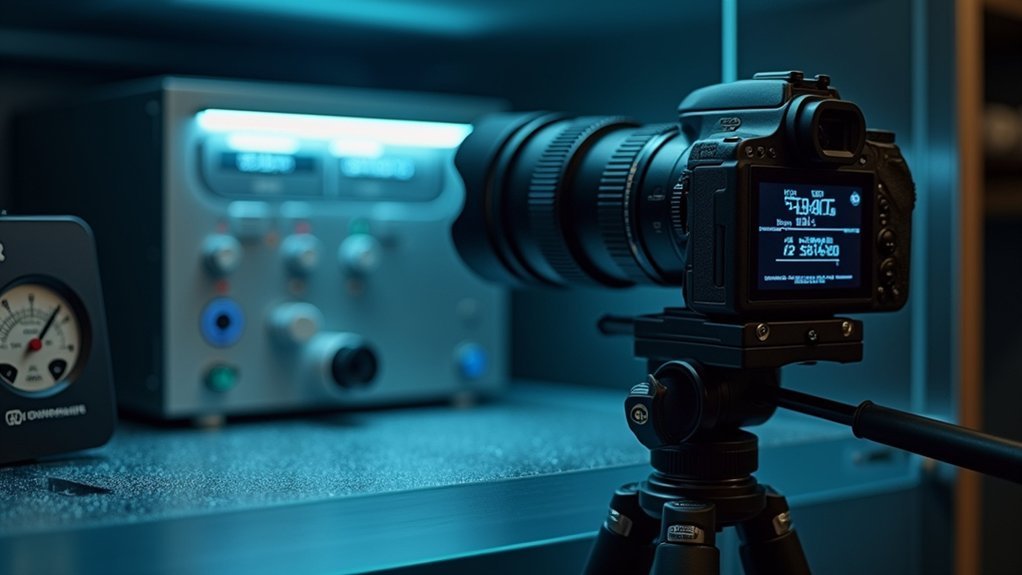
Maintaining proper humidity control in your time-lapse imaging setup prevents condensation that could damage sensitive optics and electronics.
You’ll need to establish consistent moisture levels using systems like the ImageXpress® Pico, which offers configurable humidity settings through CellReporterXpress software.
Regular monitoring of humidity conditions will help you quickly address fluctuations before they compromise your equipment or experimental results.
Condensation Prevention Strategies
When humidity levels rise unchecked in imaging environments, the risk of condensation forming on sensitive equipment surfaces increases dramatically.
You’ll need to implement effective humidity control measures to protect your valuable imaging equipment from potential short-circuits and component damage.
Consider installing desiccants or climate-controlled enclosures to reduce moisture levels in your setup. Connect humidity sensors to your imaging software for real-time monitoring, allowing you to make timely adjustments before condensation forms during time-lapse experiments.
For ideal results, conduct your work in enclosed chambers with controlled humidity settings.
Systems like the ImageXpress® Pico with built-in environmental controls offer significant advantages, maintaining stable conditions that minimize evaporation and support healthy cell growth during extended observations.
These proactive measures will substantially improve the reliability of your time-lapse imaging data.
Maintenance Against Moisture
The consistent monitoring of humidity levels forms the backbone of a reliable time-lapse imaging maintenance program. You’ll need to regularly check your humidity control systems to verify they’re functioning properly during extended experiments.
When using platforms like the ImageXpress® Pico, take advantage of built-in humidity controls to minimize evaporation and maintain stable environmental conditions for live cells. Configure user-defined humidity settings in the CellReporterXpress software to preserve healthy cell growth throughout your imaging study.
Implement real-time humidity monitoring during acquisitions so you can make immediate adjustments when necessary. This proactive maintenance approach prevents condensation on sensitive components that could lead to electrical failures and equipment damage.
Remember that consistent humidity management not only protects your valuable imaging equipment but also guarantees the integrity of your experimental results.
Establishing Proper CO2 Controls for Live Cell Time-Lapse Studies
Successful live cell imaging depends critically on stable CO2 levels throughout your experiment. When CO2 concentrations fluctuate, your cell cultures can experience metabolic disruptions and inconsistent growth rates, compromising your time-lapse imaging results.
Stable CO2 levels are the foundation of reliable live cell imaging, preventing metabolic chaos in your cultures.
You’ll want to maintain approximately 5% CO2 for mammalian cells to replicate physiological conditions essential for ideal cellular health.
Systems like ImageXpress® Pico allow you to implement user-defined CO2 controls that precisely regulate gas levels during extended imaging sessions.
Take advantage of real-time monitoring tools to immediately detect any deviations from your set parameters.
Implementing Light Management Strategies for Time-Lapse Microscopy
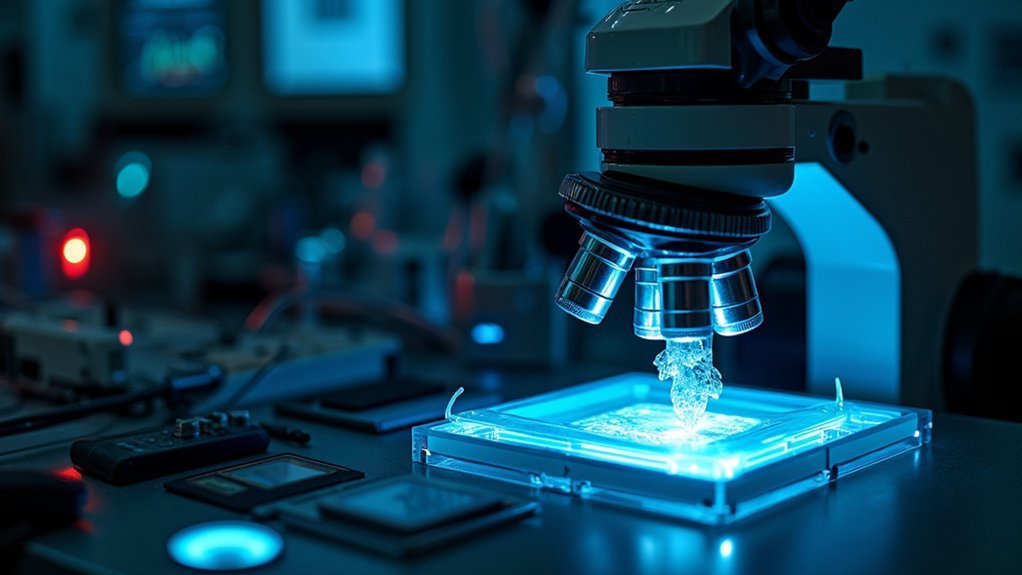
Proper light management stands as a critical factor in successful time-lapse microscopy, since excessive illumination can damage your cells and compromise experimental results.
To minimize phototoxicity, switch to LED-based illumination systems that greatly reduce harmful UV exposure while preserving fluorophore integrity during extended imaging sessions.
Carefully control your image sampling frequency—capturing fewer frames directly reduces cumulative light exposure and maintains cell health throughout your experiment.
Install an onstage incubator to maintain stable temperature and CO2 levels, which helps cells better withstand the stress of imaging conditions.
Use autofocus systems sparingly, as each adjustment introduces additional light exposure.
Designing Power Supply Solutions for Extended Time-Lapse Monitoring
When planning your extended time-lapse monitoring setup, you’ll need to weigh the benefits of solar panels against battery-only systems based on your deployment location and duration requirements.
Solar integration provides sustainable power generation for remote sites, while high-capacity rechargeable batteries guarantee continuous operation during low-light periods or inclement weather.
You can further minimize power disruptions by incorporating energy-efficient components and implementing hibernation modes that activate your system only when needed for image capture.
Solar Versus Battery Options
Selecting the right power solution represents a critical decision for any time-lapse monitoring project, especially those deployed in remote or challenging environments.
Solar panel systems offer an eco-friendly power supply for outdoor use, eliminating the need for frequent battery replacements while maximizing energy capture in sunlight-rich locations.
When choosing between solar and battery options, consider:
- Solar-powered systems with integrated high-capacity batteries provide reliable operation during extended projects, even through periods of limited sunlight
- High-efficiency solar kits optimize energy collection, making them ideal for consistent outdoor use where sunlight is abundant
- Battery-only solutions require regular maintenance but may be preferable in locations where solar exposure is unreliable
Your specific deployment environment should ultimately determine which power source will deliver the most dependable performance for your time-lapse monitoring needs.
Minimizing Power Disruptions
Maintaining uninterrupted power flow represents the backbone of successful time-lapse monitoring projects.
You’ll need to create a hybrid system combining renewable energy sources with high-capacity batteries to guarantee continuous operation in remote locations.
Integrate solar power kits with lithium-ion batteries to extend your camera’s operational duration while reducing maintenance visits.
Program your camera system to enter hibernation mode during inactive periods, markedly conserving energy resources.
Don’t overlook the importance of weather-resistant components when designing your power system.
These elements guarantee longevity in diverse environmental conditions while protecting your investment.
Schedule regular maintenance checks to identify potential issues before they cause critical failures.
This proactive approach helps maintain system integrity throughout your monitoring timeline, especially during periods when your time-lapse data is most valuable.
Setting Up Remote Monitoring and Alert Systems for Environmental Parameters
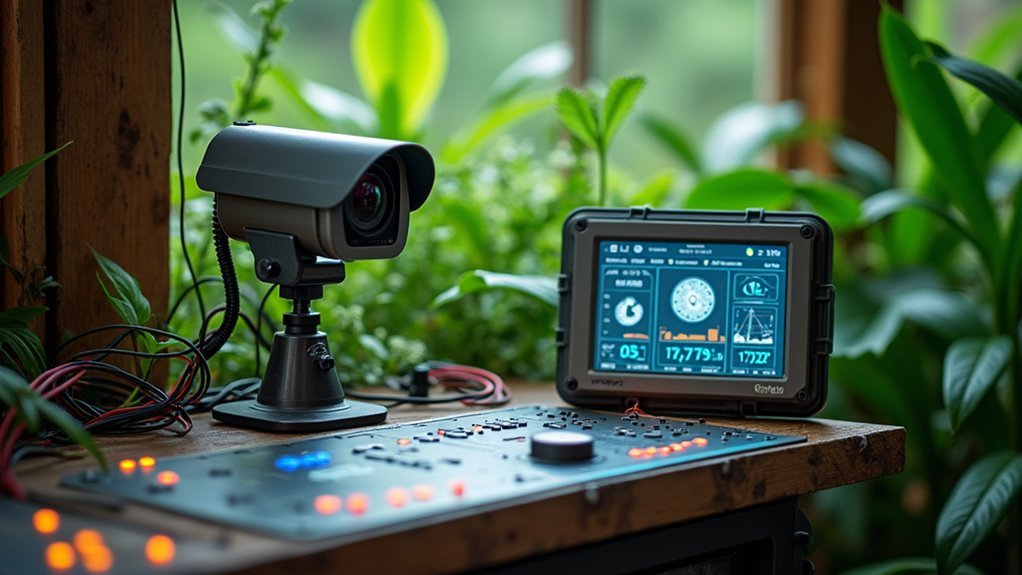
As researchers explore time-lapse imaging experiments, establishing robust remote monitoring capabilities becomes vital for maintaining experimental integrity.
You’ll gain real-time insights into significant environmental parameters like temperature, humidity, and CO2 levels from remote locations using systems like CellReporterXpress. These reliable time-lapse solutions link sensor data directly to your experiments, creating extensive records for later analysis.
- Configure alerts and notifications to immediately inform you when parameters deviate from acceptable ranges
- Implement high-precision sensors to guarantee accurate data collection throughout your long-term studies
- Establish regular data logging protocols to build historical records that correlate environmental conditions with experimental outcomes
Calibrating Image Acquisition Intervals Based on Environmental Conditions
Beyond monitoring parameters remotely, the precise calibration of image acquisition intervals directly impacts your time-lapse experiment’s success. Your image acquisition intervals must adapt to both cellular processes and environmental conditions to maintain data quality during live cell imaging.
| Process Speed | Recommended Interval | Environmental Consideration |
|---|---|---|
| Fast processes | 5-10 minutes | Higher phototoxicity risk |
| Medium changes | 15-30 minutes | Moderate temperature sensitivity |
| Slow developments | 1+ hours | Lower CO₂ fluctuation impact |
Leverage software like CellReporterXpress to implement automated acquisition schedules that respond to environmental fluctuations. You’ll need to regularly assess humidity, temperature, and light exposure throughout your experiment, making dynamic adjustments to protect cell viability while capturing meaningful data points. Remember that different cell types require customized intervals based on their sensitivity to environmental stressors.
Frequently Asked Questions
How Can I Prevent Wildlife Interference With Time-Lapse Equipment?
You’ll prevent wildlife interference by installing protective cages around your equipment, using motion sensors with deterrents, applying animal repellent, positioning cameras higher up, and creating physical barriers like fencing around your setup.
Can Time-Lapse Systems Operate Effectively in Extreme Temperatures?
Yes, time-lapse systems can operate in extreme temperatures, but you’ll need specialized housings, insulation, and heaters/coolers. High-quality cameras offer wider operating ranges, and you should check battery performance in extreme conditions.
What Software Integrates Environmental Data With Captured Images?
You’ll find that HOBO, Campbell Scientific, and LabVIEW integrate environmental data with your images. Many time-lapse systems like TLSync and TimelapseCam offer built-in solutions that automatically embed temperature and humidity readings with each capture.
How Do Seasonal Changes Affect Time-Lapse Calibration Requirements?
You’ll need to recalibrate your time-lapse settings each season. Light intensity, temperature, and humidity fluctuations affect exposure values, interval timing, and equipment performance. Don’t forget to adjust white balance for seasonal color shifts.
Are There Ethical Considerations for Time-Lapse Imaging in Sensitive Ecosystems?
Yes, you’ll need permits for sensitive areas, should minimize your equipment’s footprint, avoid wildlife disruption, and respect indigenous lands. Always prioritize ecosystem protection over capturing the perfect time-lapse sequence.
In Summary
You’ve now mastered the essentials of environmental control for time-lapse imaging. By properly managing temperature, humidity, lighting, and power supply, you’ll capture consistent, high-quality sequences without interruption. Don’t forget to implement remote monitoring systems so you’re immediately aware of any parameter shifts. With these controls in place, you’ll produce reliable time-lapse data that truly reflects your subject’s natural behavior.

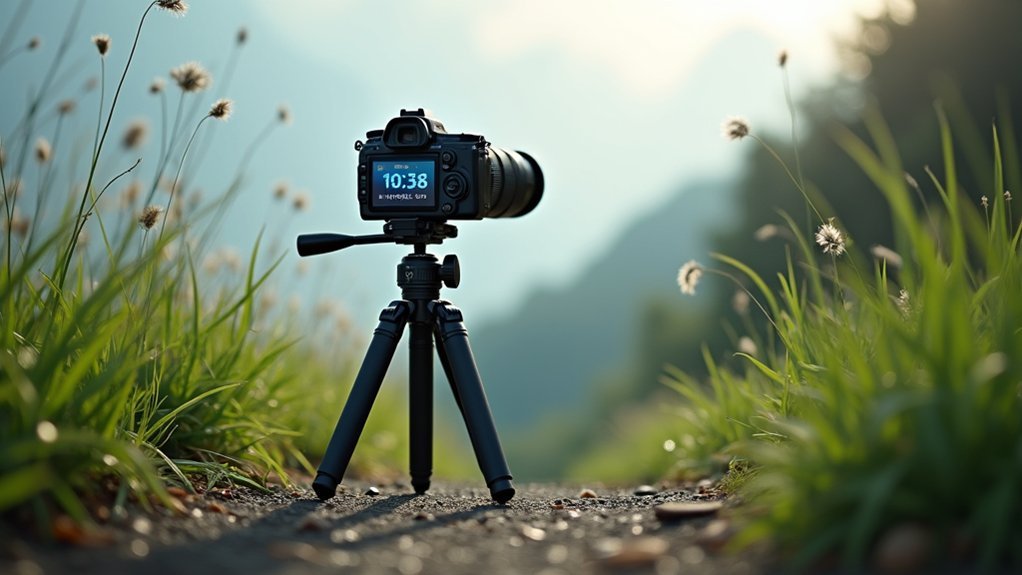



Leave a Reply